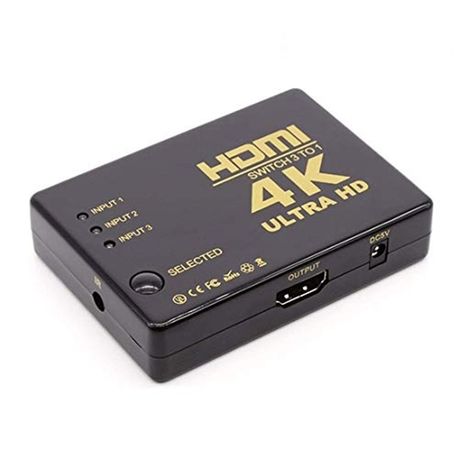Tuesday's Bloomberg Japan report only specifies that this DLSS-equipped Switch will 'reproduce game visuals at 4K quality when plugged into a TV,' as opposed to the system's portable mode—which. 4K HDMI Splitter 1x2 HDMI 2.0 Switch Ultra 4K HDR 60Hz 1080P Full HD 1 in 2 Out HDMI Switcher Converter 3 Ports HDMI Hub Adapter Support 3D Effect Full HD for Xbox360 PS4 Roku HDTV Apple TV. Model #: B08D3N1M3K. Item #: 9SIAPPJC2C6780. Return Policy: View Return Policy.
Nintendo's next Switch hardware revision has long been rumored, but details on what to expect from a possible 'Switch Pro' finally began firming up on Wednesday, thanks to an apparent leak from its screen supplier.
Bloomberg Japan has the scoop, and it points to Samsung as the source of Switch's next panel type: a 7-inch OLED panel, currently estimated at 720p resolution. That Samsung OLED production line will begin cranking in June, according to Bloomberg's unnamed sources familiar with 'internal matters.' Meanwhile, other Nintendo hardware assemblers will begin receiving the panels 'around July.'
For sizing comparisons, the current standard Nintendo Switch uses a 6.2-inch 720p LED panel, while 2019's Nintendo Switch Lite shrank its LED panel to 5.5 inches (but is also 720p in resolution).
How might “Pro” get to 4K?
Such a timetable would put Nintendo in a position to unveil the hardware 'this year' and 'prop up [Switch] demand in time for the holidays,' Bloomberg reports. Whether this means a new, larger Nintendo Switch would land on store shelves by year's end, however, was not entirely confirmed by the report.
The report also didn't clarify exactly how the system's internals might be improved, but it did allege one key feature: a bump to '4K graphics when paired with TVs.' This appears to confirm that a new Switch model will continue to employ its hybrid 'home-and-portable' gimmick.
AdvertisementHow might a 'Switch Pro' jump to 4K resolution, especially if the handheld version remains locked at 720p? Bloomberg's report doesn't speculate. In the meantime, we're wondering whether its TV dock might be updated to include extra processing chips (and thereby leverage a 'split motherboard' proposition, much like Xbox Series X/S and PlayStation 5), and/or whether Switch SoC manufacturer Nvidia has any DLSS-like tricks it can add to neatly upscale standard Switch games to 4K resolution.
Either way, Nintendo has limited history with mid-generation console refreshes that add boosts to older software. Portable systems like Game Boy Color, DSi, and 'New' Nintendo 3DS were all capable of applying processing boosts to software, but this required specific compatibility in each game—as opposed to, say, a blanket boost to 4K resolution for any Switch game imaginable.
The report also doesn't clarify whether a larger Switch will remain compatible with existing, detachable Joy-Con controllers or whether Nintendo might roll out a larger pair to match the newly larger Switch's base hardware. (The large hands among Ars Technica's staff would appreciate the latter.)
As recently as February, Nintendo told its shareholders that Switch was in the 'middle' of its life cycle, suggesting another four or five years of support, while the company offered a vague assurance about new Switch versions not being announced 'any time soon.' Previous rumors about a 'Switch Pro' emerged as recently as early 2019, but these fizzled, with only Switch Lite eventually emerging from that pool of rumored hardware refreshes.
Last week, rumors broke that Nintendo’s rumored Switch update will feature capabilities like an OLED panel, a larger display (said to be 7 inches, up from 6.2 inches), and 4K output when docked.
Two of these things are unlike the others. A larger display and an OLED, with the associated benefits of that technology, could both be fitted to the Switch as it currently exists. The third — a boost to 4K rendering when docked — isn’t something the current Switch hardware can pull off without some kind of additional upgrade.
Be advised that all of the below is speculation. Nintendo has not released any comments on any future Switch designs and ExtremeTech does not possess inside information regarding the future of the console.

The Switch poses a unique upgrade challenge that consoles like the PS5 and Xbox Series S|X don’t have to deal with. Sony and Microsoft only have to concern themselves with the living room experience. Nintendo has to address the handheld market, too. That means any changes to the Switch can’t destroy its battery life or risk making the console too hot. Keeping the handheld at 720p achieves these goals in handheld mode, but how will Nintendo deliver the horsepower required for 4K rendering in docked mode? 4K packs 4x the pixels of standard 1080p, but it’s a 9x jump from the Switch’s current 720p target.
Nvidia and Nintendo can tackle this problem from a few different directions. While Nintendo could theoretically pay Nvidia to port the Switch’s T210 SoC from 16nm to 7nm, that chip only offers 25.6GB/s of main memory bandwidth and is unlikely to support docked 4K play with such a thin pipe.
If Nintendo wants to go with a new SoC architecture, Nvidia has plenty to choose from. Nvidia’s Jetson TX2 uses Pascal instead of Maxwell, and it’s possible the company has built a new SoC variant for Nintendo based on its Turing or Ampere GPU architectures. One of these two architectures would give Nintendo a better chance to hit 4K.
Nvidia and Nintendo have three paths available to them. First, brute-force. It’s unlikely that a second port of the aged T210 down to 7nm would deliver enough performance or memory bandwidth. The Pascal-based Jetson TX2 seems to be the minimum chip for the job, and Nintendo could always pay Nvidia to build an SoC based around either Turing or Ampere. This is the most straightforward option, the simplest, and probably the least likely to deliver a great 4K gaming experience. Even the 2.3x jump in memory bandwidth from the current Switch (25.6GB/s) to the Nvidia Jetson TX2 (59.7GB/s) isn’t nearly enough to pay for the 9x increase in pixels from 720p to 4K.
There are two alternative approaches we know of: Checkerboard rendering and DLSS.
Checkerboard rendering is a technique Sony popularized with the PlayStation 4 Pro a few years back. It’s a method of rendering that leaves gaps in between the drawn pixels, like a checkerboard. Used properly, the impact on visual quality compared with native 4K is small.
Checkerboard rendering doesn’t require any features specific to Turing or Ampere and could potentially be used by the Pascal-based TX2. It’s proven and it would save bandwidth and compute horsepower compared with the pure brute-force approach.
DLSS (Deep Learning Super Sampling) is a technique Nvidia has developed for anti-aliasing that leverages machine learning and artificial intelligence to improve real-time image quality. Nvidia’s DLSS 2.0 is said to provide near native-quality images while rendering between 25-50 percent of the pixels. Nvidia trains its DLSS model on DGX-equipped supercomputers and runs the workload on your local GPU (or, in this hypothesis, on your local Switch).
The Turing and Ampere GPU micro-architectures include specialized tensor cores for handling DLSS, so any attempt to add the feature to the Switch would require upgrading to an SoC based on one of these architectures. DLSS 1.0 didn’t work particularly well, but it also relied on a game-by-game approach to improving overall image quality.
Go kart gs moon repair manual. DLSS 2.0 adopted a more generic architecture and allowed for the implementation of various quality modes. Bringing this technology to a handheld device would involve some heavy lifting, but Nintendo might be able to save power by only turning DLSS on when the console is in docked mode. If the tensor cores can be kept otherwise deactivated, Nintendo wouldn’t lose power in handheld mode just from including them on-die.
There are two reasons to be dubious of this idea. First, it requires Nintendo to make a pretty big leap forward for a mid-generation upgrade. Typically, Nintendo mid-cycle updates like the 3DS XL are faster, more efficient versions of the base platform. A Turing SoC might show up on 14nm, but any Ampere design would likely be on 7nm. Nintendo doesn’t usually leap for the latest and greatest CPU and GPU tech, so this kind of update would be a bit out of band for them.
Second, this idea assumes Nintendo would use tensor cores for upscaling, but not integrate ray tracing or other prominent Turing/Ampere features. Nvidia and AMD have packaged all these technologies together in other contexts, so it would be unusual to see them split now.
The advantages of DLSS or checkerboard rendering are big enough that we still think we’re more likely to see them than not, but Nintendo would have to be willing to push a bit out of its comfort zone to adopt them. We’ll see what the company has to say as the year progresses.

Univivi Hdmi Switch 4k 5 Port 5x1
Now Read:
